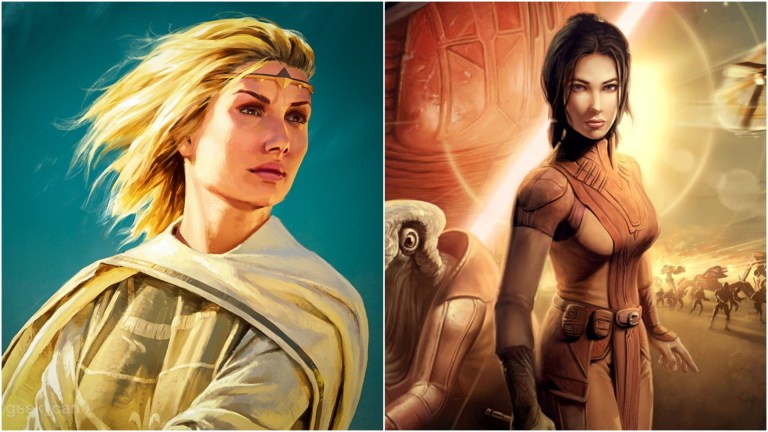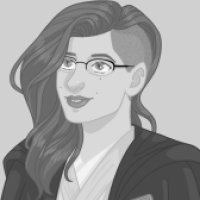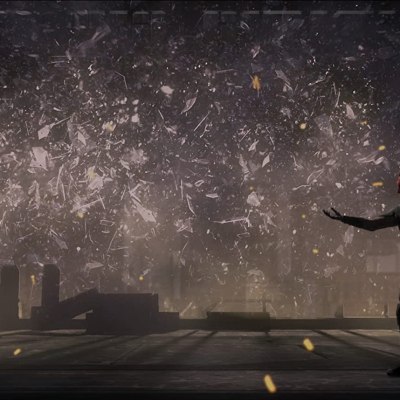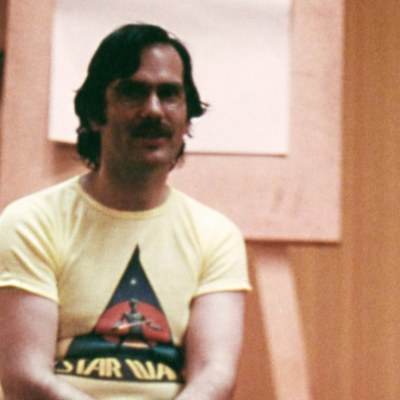What Star Wars: The High Republic Can Learn From Knights of the Old Republic
The High Republic will explore a new era of the Star Wars universe set hundreds of years before the movies, but this isn't the first time the Expanded Universe has traveled to the past.

The High Republic is the first major Star Wars publishing initiative since the end of the Sequel Trilogy. Set about 200 years before The Phantom Menace, The High Republic line of books and comics shows the Jedi in their heyday, led by new heroes and faced with new enemies and challenges. Made up of three novels (one for each age category) and comic series from Marvel and IDW, the story begins with a “Great Disaster” which disrupts hyperspace travel.
Originally slated to launch in August just days before this year’s Star Wars Celebration convention, the beginning of the series has now been pushed to January 5, 2021. Spearheading the story are all-star Star Wars writers Charles Soule, Claudia Gray, Cavan Scott, Daniel Jose Older, and Justina Ireland.
As Lucasfilm introduces a new era of stories to capture the imagination of fans, there are a few things the company could learn from the last time it introduced an era of Star Wars set hundreds of years before The Phantom Menace. We’re of course talking about the Old Republic era, the setting of Star Wars adventures like the Tales of the Jedi comics and Knights of the Old Republic video game. While the Dark Horse comics spawned this era of war between the Jedi and the Sith (and later, the Mandalorians), it’s arguably the video game that solidified the Old Republic as a fan-favorite era in Star Wars history.
Knights of the Old Republic showed fans an era of Star Wars not completely unlike the one in the movies but that also felt new, with uncharted planets to explore and legendary characters to meet. This is the same balance that The High Republic will have to strike to be successful. Here are the lessons The High Republic can learn from Knights of the Old Republic:
Avoid the Skywalker Saga
Knights of the Old Republic had its own powerhouse character in Darth Revan. It didn’t try to connect Revan’s story to the Skywalkers or to rely on a family legacy for ideas about the Force. That’s one of the benefits of working outside of the movies: you can play around more freely with new characters instead of relying on cameos from old favorites.
Set 4,000 years before the film saga, developer BioWare was able to do pretty much anything it wanted with the game’s characters, planets, and factions without interfering with the movies. 200 years into the past isn’t as long of a time jump, but it still means The High Republic can avoid retreading Prequel era stories that have been told before.
The High Republic will have some element of family legacy, though. According to Lucasfilm, this era will explore “the Starros and San Tekka clans,” a reference to Lor San Tekka, a minor character in The Force Awakens, and Sana Starros, a friend of Han Solo in the recent Marvel comics. Hopefully, these connections to the Skywalker Saga will be in support of a new story and not a way to drive readers back to the Original and Sequel Trilogies.
Deeper Lore
One of the strengths of the original Star Wars was that the galaxy felt lived in and full of history. Even if you were only following Luke’s story, mention of historical events like the Clone Wars and the battered quality of the ships immediately established that a lot had happened before the movie had even started.
Today, we know the Star Wars galaxy is vast both in time and space, and one of the benefits of a story set before what we’ve already seen is reaching farther back in time to unlock new mysteries and lore. After all, exploring ancient ruins and thousand-year-old temples is part of the fantasy of Star Wars.
Knights of the Old Republic established various ancient aliens, including the Rakata, which created the puzzles and ruins key to Revan’s story. It also explored Korriban, a secret Sith planet and the final resting place of several Sith lords, as well as old Jedi enclaves where masters taught a legendary generation of Jedi Knights.
Since The High Republic will focus on Jedi, this is a chance for readers to learn more about what traditions have been passed down and how they might have changed between the High Republic and the Prequel eras. The introduction of the Nihil, the “space Vikings” billed as the villains of the story, could also be a way to show more of the “Wild West” aspect of the era before all sectors of the galaxy were under the jurisdiction of the Galactic Republic.
More Varied Characters
From the Original Trilogy templates of farmboy Jedi, smuggler with a heart of gold, and warrior princess came a near-infinite variety of characters types. Knights of the Old Republic starred Republic soldiers, an arrogant Jedi, and a murderous droid named HK-47 that couldn’t have been less like C-3PO.
And at the center of the story was a Sith lord suffering from amnesia who was unlike any “villain” we’d ever seen before in Star Wars. Revan was a former bad guy tricked into becoming a hero by his Jedi custodians, a big character twist that’s still regarded as one of the big moments in Star Wars history.
The High Republic is yet another chance for storytellers to introduce new kinds of characters never before seen in the canon. So far, we know there will be a primarily Jedi cast with a variety of species, ages, and experiences, but the unsettled territories of the galaxy could also provide some surprising characters.
Aliens Acting Against Type
Star Wars has a tendency to “typecast” alien species. If the first Zabrak character ever seen on screen was Darth Maul, future members of the same species are probably going to be warlike, acrobatic, and tough. Even a Jedi Master of this species was known primarily for his thick skin and rough upbringing. But Knights of the Old Republic II: The Sith Lords introduced a very different type of Zabrak: a soft-spoken mechanic named Bao-Dur who was good at a different kind of killing (he had invented a super-weapon and regretted it).
Meanwhile, the first Twi’leks were servants in Jabba’s Palace in Return of the Jedi, potentially dooming all members of their species to some form of slavery. But Knights of the Old Republic gave us Mission Vao, a street-smart thief who would fit in perfectly with the smugglers and scoundrels of the galaxy.
The High Republic has a chance to give aliens as much diversity as humans. We know that the cast will feature at least two alien characters, the Twi’lek Loden Greatstorm and the Mirialin Vern Rwoh. What other characters might the series introduce and how might they surprise us?
New Jedi Abilities
If the High Republic is the heyday of the Jedi, Force powers must play a big part in this golden age. Knights of the Old Republic popularized Jedi Battle Meditation, a special power that allows certain Force users to turn the tide of massive battles. In the game, Jedi hero Bastila Shan is considered one of the most powerful knights in the galaxy due to the way she can influence entire war fleets. (In Tales of the Jedi, hero Nomi Sunrider could also use Battle Meditation to defeat enemies without having to lift her lightsaber.)
The High Republic cast is supposed to include some of the best Jedi who ever lived. “Best” doesn’t just mean martial prowess, either. In fact, since this era takes place before Sidious’ rise, the Jedi are supposed to be more ethically-minded than the ones in the Prequels. Master Avar Kriss is described as “compassionate, not dogmatic, and always ready to sacrifice herself over others.” This might lend itself to new kinds of Force healing or other powers that help others become stronger.
Ancient Science
Star Wars is science-fantasy at its core, magical crystals powering lasers. The combination of the two genres is key to telling a great story set in this universe. In Knights of the Old Republic, this aesthetic manifests itself in the ancient Rakatan technology that leads players through their adventure. Revan, Bastila, and the rest of the cast hunt for ancient Star Maps, exploring the deepest corners of several planets to find these artifacts powered by the dark side of the Force.
After finding all the Star Maps, the characters uncover the mystery of the Star Forge, an enormous factory in space built by the Rakatan Empire in order to produce the greatest army in the galaxy. But while the Star Forge was designed to slowly feed off the energy of a nearby star, it also fed on the dark side energy of the Rakata themselves, eventually leading to the fall of their Infinite Empire. In essence, the Rakata had created a self-aware dark side superweapon that led to their own destruction.
The High Republic will visit a place called the Starlight Beacon, a station that serves as a lighthouse meant to help space travelers navigate dangerous hyperspace routes. Is there more to the origin of this station? And what else might the Jedi uncover in the uncharted parts of the galaxy? We hope to see interesting new technology in the series that fuses science with magic.


